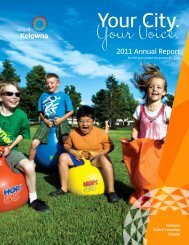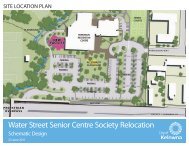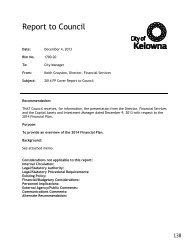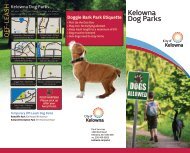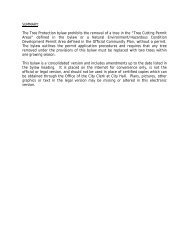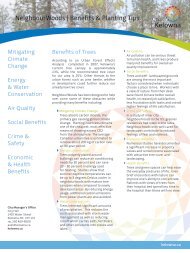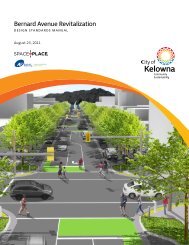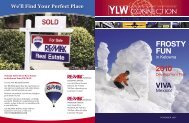Comprehensive Site Development Plan ... - City of Kelowna
Comprehensive Site Development Plan ... - City of Kelowna
Comprehensive Site Development Plan ... - City of Kelowna
You also want an ePaper? Increase the reach of your titles
YUMPU automatically turns print PDFs into web optimized ePapers that Google loves.
Avocets at Glenmore Landfill<br />
5<br />
There is considerable time (5-10 years) before the remaining wetlands in the Glenmore Landfill<br />
are needed for landfill purposes. This gives us the comfort <strong>of</strong> having a number <strong>of</strong> years to attempt<br />
to encourage the colony to move to <strong>of</strong>fsite habitats. As that scenario would be by far the most<br />
cost-effective mitigation scenario, considerable effort should be made to make that occur.<br />
Another reason to encourage the movement <strong>of</strong> the colony to an <strong>of</strong>fsite location is that although<br />
American Avocets presently breed successfully at the Glenmore Landfill, there are no guarantees<br />
that as the landfill expands they will not abandon the site due to disturbance, or as conditions<br />
change.<br />
If a colony becomes established at Robert Lake, or other wetlands, whether or not avocets<br />
continue to nest at the Glenmore Landfill, then the danger <strong>of</strong> extirpation in the Okanagan valley<br />
becomes diminished. This hoped-for result would give resource managers short term comfort<br />
while planning for long term conservation <strong>of</strong> avocets, and a long-term option to perhaps more<br />
fully develop the Glenmore Landfill as pressure to expand the landfill increases, without<br />
endangering the Okanagan avocet population.<br />
3.2 Alternative breeding habitat at Slough No. 2 and Bubna Slough<br />
At the same time as habitat enhancement work is being conducted at Robert Lake, a few nesting<br />
platforms should be installed at Slough No. 2 and Bubna Slough. These wetlands have not been<br />
used by avocets previously, but it would be an inexpensive experiment and, if successful, would<br />
provide additional conservation options.<br />
3.3 Potential for <strong>of</strong>f-site mitigation at Robert Lake<br />
Robert Lake is regularly used for foraging and nesting occurred once. There appears to be ample<br />
shoreline to support a breeding colony <strong>of</strong> American Avocets. This shoreline currently attracts a<br />
number <strong>of</strong> migrant and local avocets to forage. Clusters <strong>of</strong> artificial floating nesting islands<br />
might be used to stimulate colony development, but this would have to be tested before this could<br />
be relied on as a mitigation method. These might be preferable to constructing permanent low<br />
islands with 12:1 side slopes on public land or rights-<strong>of</strong>-way in the lake as water levels cannot be<br />
controlled at the present time. Permanent islands might be flooded in some years, and connected<br />
to the mainland in other years, thereby becoming unsuitable for nesting avocets. However, there<br />
are water management options that could control water levels, if all stakeholders agreed.<br />
Unless private owners were amenable to making portions <strong>of</strong> land available, the best option on<br />
public land for construction <strong>of</strong> permanent islands would be for a single island (0.07 ha or 30-m<br />
diameter) in the south west corner. That part <strong>of</strong> Robert Lake is presently owned by Central<br />
Okanagan Regional District and could be managed as parkland (Weir and Gyug 1999).<br />
3.4 Maintain existing wetland habitat at the Glenmore Landfill for breeding<br />
avocets<br />
While attempts to encourage the breeding colony to move elsewhere are underway, it is<br />
imperative that the existing wetland at the Glenmore Landfill is retained. It may be necessary to<br />
manage water levels in such a way as to make the landfill site less desirable s nesting habitat than<br />
usual, but the wetland should be retained in such a condition that it could be restored to a suitable<br />
condition quickly.<br />
Manning, Cooper and Associates



